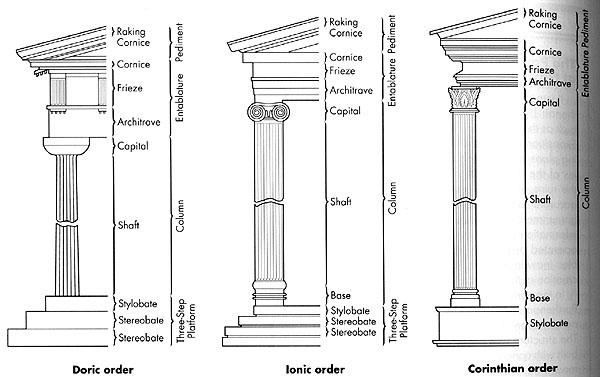


Greece
Previous to the rise of a stable culture on mainland Greece, civilization developed on the Island of Crete and in Mycenae, around 1500 B.C. Here, civilization flourished until a tribe from the north called the Dorians raided the lands c.1100 B.C. After the Dorian invasions, the people who occupied Greece became nomadic, but eventually settled into small independent City States somewhere around 800 B.C. It was within these city states that the Greek notions of democracy and their ideals both in art and politics came to the forefront of everyday life. .
Architecture
The Acropolis at Athens, Greece.
Perhaps the Greek's greatest contribution to civilization lie in their development of new architectural forms and styles. The Greeks, in the building of secular temples dedicated to their vast pantheon of gods, developed three main styles of architecture, based on the post and lintel system of structural development.
The Greek Architectural Orders.
The Greek orders and their elements are visible in Greek temples, as well as in many of today's structures. What kind of buildings do the temples below remind you of? What does their appearance suggest? What orders are used in the two temples below? Why do they appear to be ''incomplete'' or in such advanced stages of dis-repair?
The Temple of Athena Nike, c. 427 B.C., Athens Greece.
The Parthenon, c. 447 B.C., Athens Greece.
Sculpture
A Greek Kore and Kouros, c.525 B.C., Greece.
Images such as the Kore (girl) and Kouros (boy) above were typical of early Greek Sculpture, prior to what historians have called the classical period. What elements or features are common to both scultures? Do they appear lifelike or stylized? How is the body divided up?
Myron: The Discobolus, 450 B.C., Greece.
Nike Adjusting Her Sandal from the Temple of Athena Nike, 410 B.C., Athens Greece.
The Nike of Samothrace, 190 B.C., Greece.
The three sculptures above were all created in the Classical style of Greek sculpture. How do these later sculptures differ from the Kore and the Kouros? Are there any similarities? What would they have been used for?
Painting
Greek painting was not limited to vases, but sadly vase-painting is the only medium that has survived the centuries. Look at the two images below. The first is from the earlier, black-figure style of vase painting, the second, from the later red-figure style. Can you guess as to how the two paintings were produced? What techniques would have been used?
Black Figure Geometric Amphora, c. 700 B.C., Greece.
Red Figure Krater, c. 400 B.C., Athens Greece.













